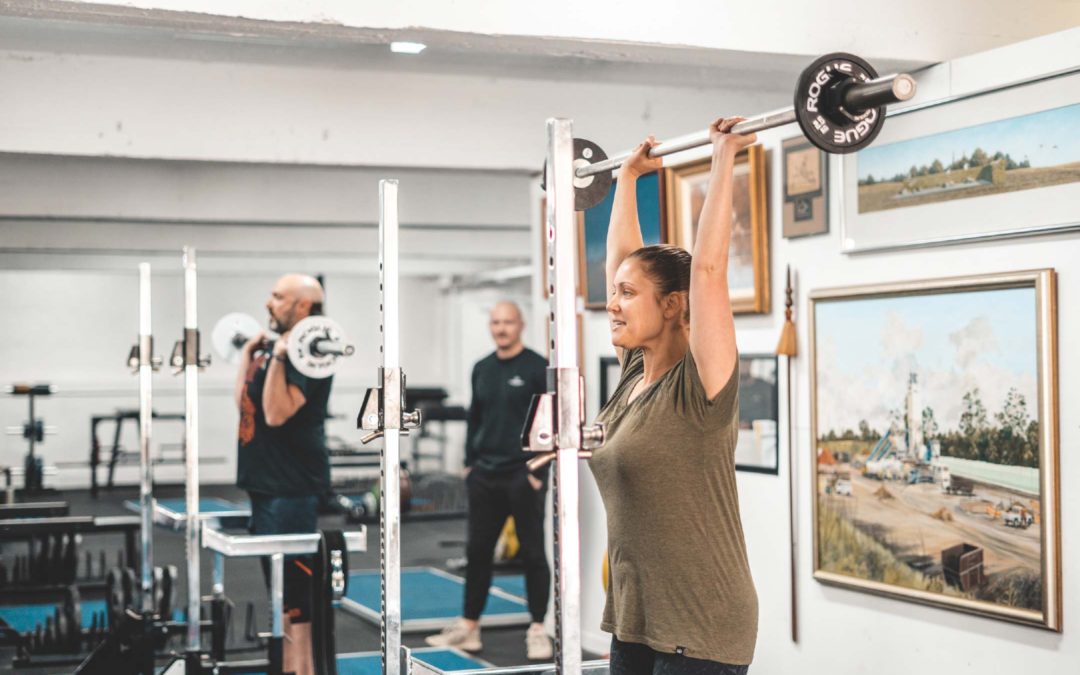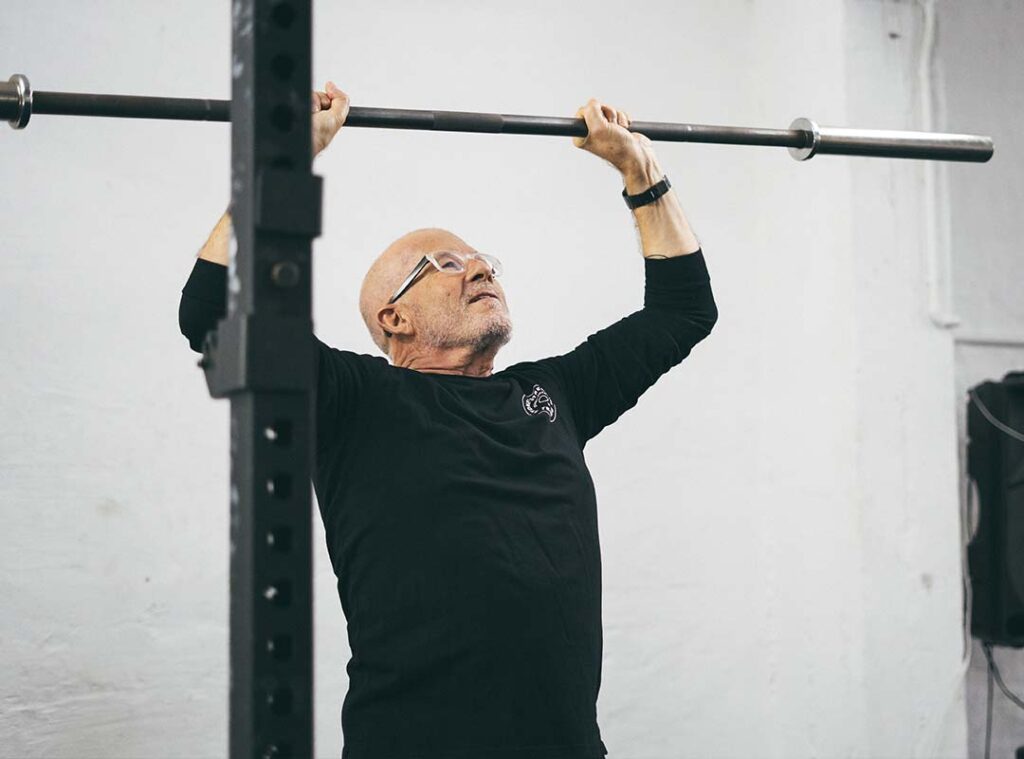Shoulder pain is one of the most common complaints in both athletes and everyday gym-goers. From rotator cuff irritation to osteoarthritis, shoulder issues can limit your ability to reach overhead, press weight, or even perform daily tasks. Although it’s the easy way out, avoiding overhead movements permanently isn’t the answer. In fact, we argue that the Overhead Press, when appropriately loaded can, be a powerful tool for building strength, improving function, and keeping shoulders resilient. As a quick aside, when referring to the Overhead Press in this article, it may also be called the Standing Press or simply a “press”. With that in mind, let’s tackle three questions:
- What exercise is best for shoulder pain?
- How do you strengthen a weak shoulder?
- What shoulder exercise builds the most mass?
If you’re looking for shoulders that are stronger for life, read on.
What exercise is best for shoulder pain?
Pain around the shoulder can often lead people to stop pressing overhead. Yet research shows that exercise is a first-line treatment for common shoulder issues like rotator cuff tendinopathy and osteoarthritis ¹. Strengthening the surrounding muscles helps improve range of motion, reduce pain, and increase function. There’s is no best exercise however. It’s important to approach every individual differently and ascertain the correct starting point. That being said, the Overhead Press, which emphasises the front and lateral deltoid, triceps, trapezius, rhomboids and rotator cuff muscles can be modified to almost any level. For instance, we often employ the following modifications:
- Dumbbells instead of Barbells to allow freer movement each arm and different orientations (i.e., neutral grip)
- Seated presses or landmine presses for extra stability across the lower and upper back
- Modifying range of motion during barbell pressing using the pins in a squat rack to press from or lower to
- Simply reducing the load and building it back up gradually as tolerance improves
Remember, movement is medicine, and avoiding shoulder loading entirely may actually worsen symptoms over time.
How do you strengthen a weak shoulder?
Strengthening a weak shoulder is no different from training any other muscle group – no special approach is required. A balanced upper-body program should include pressing (Overhead and Bench Press), pulling (Pull-ups and Rows), and accessory work (arm and isolation shoulder work). These movements strengthen the rhomboids, posterior deltoid, lats, pecs, and rotator cuff, all of which support the shoulder and scapula. Even arm isolation work, like biceps curls or triceps extensions, can help when overhead movement is limited. This is partly because the biceps and triceps both insert across the shoulder and additionally, the muscles in the scapula and rotator cuff act to resist forces imposed on them when the arms are moving. As such, there’s always something someone can do, even if it isn’t directly overhead pressing!
When building back up, on the lowest end, someone can start with two sessions per week and one to two sets per exercise. As strength improves, volume can be split across three sessions per week and around three sets per exercise. Basic progression such as adding reps gradually or increasing weight by 2 – 5% when possible is appropriate. As always, we encourage using Rate of Perceived Exertion (RPE) to monitor effort, aiming for a “hard” to “very hard” last rep (RPE 7 – 9) without going to absolute failure ².
What shoulder exercise trains the most muscle mass?
Specialty or “rehab” exercises can feel like the safest option when you have shoulder pain. These are usually light-weight movements aimed at “stabilising” the scapula or surrounding muscles. However, they aren’t magic as research shows they are not uniquely superior to standard resistance exercises ³. Their real value comes from what they allow compared to heavy lifts like the Barbell Overhead Press. Especially for someone less trained, they enable loading at lower loads with higher reps to build capacity. Additionally, by isolating sensitive areas, we can avoid overloading the entire shoulder. Lastly, they can act as a warm-up in certain cases to help someone tolerate heavier pressing later.
However, when it comes to training the most muscle mass, The Overhead Press is king. For hypertrophy, the press is one of the best ways to build shoulders. It works all three deltoid heads, triceps, upper chest, and upper back (rhomboids and trapezius). The standing press also engages the lower back in extension. Research shows that no posture or movement is uniquely harmful for the lower back, but some people may feel it work hard during presses ⁴. In cases when overhead pressing is painful, low-load options like lateral raises or even Y-raises and band external rotations can maintain shoulder capacity. That being said, we prefer close substitutions. Press variations such as high-incline dumbbell presses are a favourite. They allow you to keep strength and progress something meaningful while symptoms calm before gradually returning to full standing work.
Final thoughts
Shoulder pain doesn’t mean you have to stop training. It means you simply need to switch strategies. The overhead press and its variations are safe for most people and remain one of the best ways to build shoulder strength and muscle. However, at times it may not be the most appropriate choice. Someone may need to utilise a variation that feels is tolerable, whether that’s dumbbells, a landmine press, or a reduced range of motion. For a short while, someone may need to instead use alternative exercises. As always, we recommend individuals progress gradually by adding reps or weight and monitor effort using RPE to avoid unnecessary flare-ups.
A stronger shoulder is usually a healthier shoulder. By staying consistent with pressing, pulling, and accessory work, you can build resilience, reduce pain, and get back to doing the lifts you enjoy. Don’t avoid shoulder training, adapt it to your current level and let strength be the solution. If you’re looking for more expert guidance in dealing with pain, getting stronger and improving your quality of life, contact us today.
References:
- Are progressive shoulder exercises feasible in patients with glenohumeral osteoarthritis or rotator cuff tear arthropathy? – PubMed
- AUSactive-Exercise-Guidelines-Resistance-Exercise-Prescriptions-for-Healthy-Adults.pdf
- Causal mechanisms of a scapular stabilization intervention for patients with subacromial pain syndrome: a secondary analysis of a randomized controlled trial – PubMed
- No consensus on causality of spine postures or physical exposure and low back pain: A systematic review of systematic reviews – PubMed

